The Botha G.R.Mk.I was ordered into production 'straight off the drawing board' to Specifications 10/36. Designed to Specifications M.15/35 for Blackburn by G. E. Petty, the Botha was to exhibit such shortcomings that it was withdrawn after only a brief spell on operations. Contracts for 486 aircraft being placed in December 1936, but it took over two years before the pair of prototypes, s/n L6104 and L6105, made their maiden flights in the spring of 1939, followed by the first production Botha I in July 1939.
In appearance the Botha was a clean and quite attractive high-wing monoplane of stressed-skin construction. Alternative engines fitted were two 880 hp Perseus Xs or 930 hp Perseus XAs, and the Botha was armed with a single fixed 0.303 (7.7 mm) gun for the pilot and a pair of 0.303 (7.7 mm) guns in a power-driven dorsal turret. The high-wing layout facilitated housing of the torpedo internally without making it necessary to deepen the fuselage inordinately.
Meanwhile, a second production line had been started at the Scottish factory of Blackburn Aircraft at Dumbarton, where the first Botha was due to be delivered in August 1939. Production orders finally totaled 578, the serial numbers allocated being L6106-L6345, L6347-L6546, W5017-W5056, W5065-W5114, W5118-W5157 and W5162-W5169. Additional production of the Botha by Boulton Paul was planned to Specification 39/36, and Specification 45/36 was drawn up for further production by Blackburn, but neither project was proceeded with.
The Botha was just too late to reach Coastal Command squadrons by the outbreak of war. Superseding Avro Ansons, first deliveries were made to No. 608 (North Riding) Squadron of the Auxiliary Air Force at Thornaby in October 1939. The Botha became the first Blackburn aircraft to serve with a land-based squadron of the RAF since the Kangaroos of No. 246 Squadron in 1918. Some Bothas also went to No. 502 Squadron at Aldergrove.
The Botha was seriously underpowered and its shortcomings were such that the type was not issued to other squadrons, as had been planned, but continued to serve with No. 608 Squadron, chiefly on patrols over the North Sea, until April 1941, when they were finally withdrawn from operational flying. It was subsequently employed in operational training duties, mainly with Air Navigation and Air Gunnery Schools. It remained active in this role until 1944.
